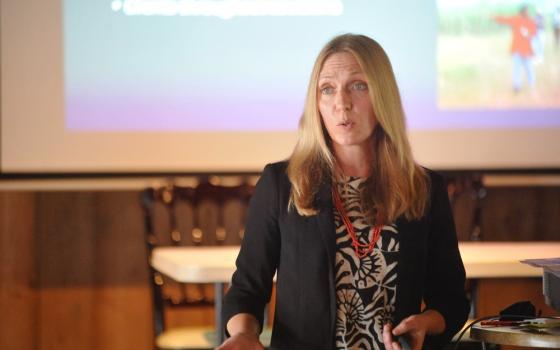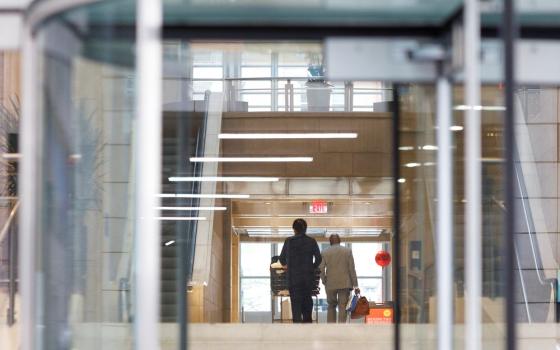Holy Week: Accompanying El Salvador
On this Holy Saturday we enter the dark interval between death and promise. I am running out of words, a good sign, for we are approaching a threshold where logic ends and mystery begins. The Holy Week story was always there, written long before the events we will review in the grand sweep of salvation history recorded in the lectionary readings for tonight's solemn Easter Vigil.
The secret of our salvation was traced long ago like the hidden spirals of DNA folded into creation itself. Our divine destiny has always been present in the profound but ordinary, divine but intimately human mystery of the Incarnation. God has been embodied in history from the beginning.
We will travel from one garden to another, where the Happy Fault of the first Adam will be met with a second Eve weeping before an empty tomb. Grace was already at work perfecting nature even before Jesus made his final journey to the cross. The tragic story hides an epiphany, has always held clues for us to help us discover our inheritance. We just needed to grow up to claim it and to learn to read what the Law and the Prophets have always told us plainly: There can be no glory without suffering.
Romero was given a magnificent tomb, a stately bronze cover for his grave in the form of a reclining vested archbishop attended by four hooded figures holding the Gospels. The Word of God formed him; it was his true voice in life. His martyrdom sealed his identity as Servant of God. He will be canonized, some day, when the church figures out what to do with so great a prophet, when we are ready for a leader who can point the way to an uncertain future. For now, it seems, Romero is still a dangerous memory, too potent to fit inside the gilded borders of a holy card or to be cornered within any spiritual niche that is less than the Gospel itself.
Dorothy Day, asked once if she might be canonized, snorted that she would not be dismissed that easily. Romero, like Jesus himself, has a tomb but has already moved on among the disappeared. Holiness is simply too big to be enshrined. It goes on ahead into Galilee, where a mysterious figure on the shore of the lake will catch the apostles by surprise, already back to their livelihood of boats and fishing. Romero has likewise escaped all attempts to define him or narrow his message to serve any ideological agenda. We have only just begun to comprehend the gift he is to the church and to the world in these urgent times.
 So where is the resurrection? How will we know it, not as just history or even mystery, but as something we can feel in our flesh. What is resurrection if not the belief that we are being blessed right now beyond our wildest imaginings with new life and the power to work miracles as members of the risen body of Christ, if only are willing to let the Spirit breath in us.
So where is the resurrection? How will we know it, not as just history or even mystery, but as something we can feel in our flesh. What is resurrection if not the belief that we are being blessed right now beyond our wildest imaginings with new life and the power to work miracles as members of the risen body of Christ, if only are willing to let the Spirit breath in us.
Romero boldly predicted that if he was killed, he would rise again in the Salvadoran people. Who would challenge this claim now? An obscure prelate in a tiny Central American country swept into the maelstrom of the Cold War and murdered by mercenaries has emerged today as light and hope for the world's poorest nations and as a warning to its richest. To paraphrase Jesuit Fr. Jon Sobrino, speaking in San Salvador during the Romero commemorations, we stand at two thresholds, conversion and hope. “A different church [world] is necessary, and a different church [world] is possible.” If we can hear this invitation, we can go forward.
During the Mass in the Cathedral crypt on March 24, I received Communion and then worked my way back through the crowd to view the fourteen photographs that so graphically record Romero's death, displayed as stations of the cross near his tomb. They show him on the floor behind the altar of the hospital chapel where he was saying Mass when the assassin struck. A fountain of blood is pouring from his nose and ears, pooling under his crumpled body. The sisters and lay people at the Mass surround him, one cradles his head, then they lift him up and rush him to a waiting truck bed for a final desperate race to the hospital. Though he continued to gasp for breath as blood filled his lungs, he was unconscious and already beyond help or history.
It is a shocking tableau, but as I moved to the last station, what moved me most was the image of his body, the blood wiped from his face, now tranquil and in repose, surrounded by those who loved him, holding him in their gaze as they absorb this terrible moment and the absolute silence that follows every death. It was finished. He had remained faithful to the end. The martyrdom he had known, day and night for three long years, would be his, had come for him at last.
His murderers ended Romero's life, but they did not have the last word. The scriptures he loved and that had in turn scripted his life as archbishop were already audible in the powerful, multi-layered interpretive elegy that 30 years later has not ceased nor been exhausted. “Take your rest now, Oscar Arnulfo Romero, good and faithful servant. Blessed are you who hungered and thirsted for justice. This is my beloved son in whom I am well pleased.”
 If we only enshrine him in our memories, we will have missed the point. We honor him best by imitating his life and his commitment to serving the poor, telling the truth, working for social transformation toward a world that will respect the dignity of every human person. The resurrection belongs to those who will, each in their own way, do this. They know their names. We hold one another together now toward the promise of a different church and a different world, both necessary and possible.
If we only enshrine him in our memories, we will have missed the point. We honor him best by imitating his life and his commitment to serving the poor, telling the truth, working for social transformation toward a world that will respect the dignity of every human person. The resurrection belongs to those who will, each in their own way, do this. They know their names. We hold one another together now toward the promise of a different church and a different world, both necessary and possible.
To the students, staff and parents at Northwest High School in Seattle, the members of the Lutheran community in San Francisco and St. Regis Church in Kansas City, to Srs Maria and Christine, to the community members serving the school and community of San Carlos Lempa, to Joe, Jill, Alejandro, Dan and Mike, to Arlirio Hernandez in Ysidro, now being stalked by killers for his opposition to mining, to Arnoldo Garcia Cruz, his wife Dinora and their daughters Jenny and Karen, my hosts in San Carlos, to Miguel and Terry of Austin, Texas, to Rebecca, who made up my room each day at the Hotel Alameda, to the 16-year-old boy who bravely folded origami birds with me in Cabañas, and all the children across El Salvador who smiled at me and welcomed me into their world, and to the SHARE [http://www.share-elsalvador.org] staff, Laura, José, Alicia, Tedde, Bethany, Jillian and Nicholas, and to Scott Wright, Gene and Guadalupe Montalvo-Palumbo, Kevin and Trena Yonkers-Talz and the Casa de la Solidaridad community [http://www.scu.edu/studyabroad/casa/], to my wife Diane and our own Juan Marrin, to my brother Jim Barnett and all those who, like Gigi Gruenke, have lived the story from the inside out, and to Teresa and her countless beautiful friends in El Salvador and everywhere, I say thank you and Happy Easter.
[Pat Marrin is editor of Celebration, NCR’s worship resource. He was in El Salvador covering the events surrounding the 30th anniversary of the assassination of Archbishop Oscar Romero, which was March 24.]
March 29: Holy Week 2010: Accompanying El Salvador, an introduction
March 30: Anointing
March 31: Darkness will have its hour
April 1, Holy Thursday: Fools rush in
April 2, Good Friday: Know when to fold 'em
April 3, Easter Vigil: Know when to hold 'em
| See also |



